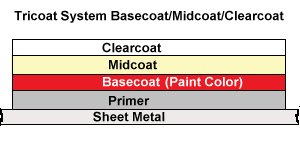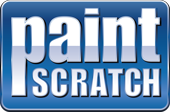Tri-coats
Tri-coats
Any color that has the word "Tri-coat" in the paint name listed on our site has three different coats of paint applied at the factory. The first is a basecoat of color. Next a second coat of transparent color, called the midcoat is applied and finally, a coat of clearcoat. The midcoat color is applied very thin and adds additional depth to the paint. In order to successfully match a tri-coat, you should practice on a scrap piece of metal or plastic.

Application
First apply the basecoat. This is the main color coat. Make sure this has thoroughly dried for at least a few hours. Next, apply the midcoat layer. This bottle (or spray can) will have a check by the word Tricoat (or Midcoat) or a #2 on the label to identify it. This color goes on very thinly and you must practice a bit to get it right. Finally, you apply the clearcoat to achieve the correct color. Follow this link for pricing.
When spraying tricoats, apply the basecoat first. Spray the midcoat out even farther than the basecoat or you will create a paint layer line. The best was to spray tricoats is to spray the entire panel to the edge so there are no paint layer lines. Again, practice, practice, practice off the vehicle first before applying a tricoat to your vehicle!
Make sure to get the primer and basecoat sanded very smooth before applying the additional stages of paint. The primer should be wet sanded before applying the paint. Once the midcoat is applied over the basecoat, it becomes very difficult to smooth the basecoat paint. You can use #1000 grit sandpaper or rubbing compound (cutting creme) to smooth the paint. Always let the basecoat dry thoroughly before applying the midcoat. Then, let the midcoat dry thoroughly before applying the clearcoat.
When you apply the basecoat and midcoat you follow the same directions given at "How to Apply" for each coat. The real trick is applying the midcoat over the basecoat to achieve the right color. It's like using a colored transparent piece of plastic (think Saran Wrap with colors) over the basecoat to change the color. Add too little, and the basecoat won't be changed enough; add too much, and you will change the basecoat too much and have to start over again. Make sure you PRACTICE OFF the vehicle to see how it turns out and keep comparing your practice work to the vehicle color. Midcoats are best sprayed, but if you use very thin coats, you can do a reasonable job.
Final Thoughts
Applying midcoats is more difficult than a regular base-coat/clearcoat combination but with some practice you can achieve satisfactory results. Because these can be very tricky, you may want to consider having a professional apply this paint or leave the entire job to a collision shop. However, it is also a very expensive repair job in the shop so why not try it yourself first to see how it turns out!
Please contact us with any comments you have or any additional tips that worked for you!





